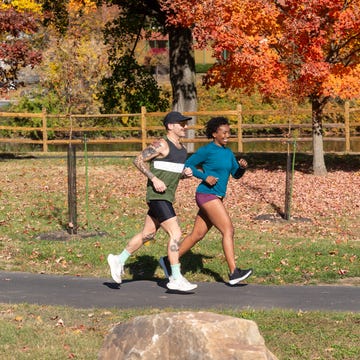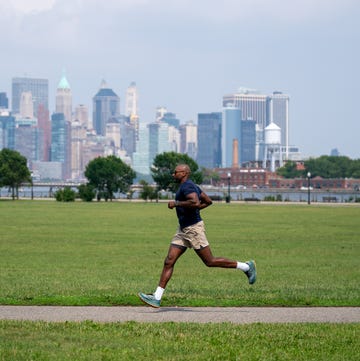Have you ever been midrun, struggling to go a little farther or a little faster, and thought “Am I doing this right?”
Running may seem like a simple activity, but understanding a few key concepts—breathing, form, and pacing—as well as the strategies you need to improve, are the reasons every athlete—from beginners to those who have been on the road for a while—should sign up for a running class.
If you do, you won’t be alone. In 2024, for the third year in a row, running was a top 10 workout class booked by users of the digital scheduling platform ClassPass. That’s not totally shocking because running classes can take place in gyms, virtually, or outdoors on the road, track, or trails.
“Whatever your goals, the biggest benefit of running classes is their ability to turn an individual sport into a group activity,” Marcel Dinkins, C.S.C.S., a Peloton instructor, tells Runner’s World. “While you’re an individual runner, in a class, you are also part of the team. Training can be isolated and lonely, and tread classes take the loneliness out of running.” The same is true of in-person classes.
You not only get potential learning moments with a class, but the added motivation of working with other like-minded people to stay on task.
In a 2022 Frontiers in Sports and Active Living study, a sample of 800 first-time racers registered for the 2019 7K or 15K Seven Hills Run in The Netherlands found that those who trained with others, no matter their ability level, were more likely to show up for scheduled runs. Even those runners who claimed not to be motivated to run with others benefitted from the social runs. The researchers concluded that social networks play an important role in maintaining a consistent training habit and in reaching set goals, such as participating in a race.
From beginner classes focused on the basics to training classes that get you ready for a marathon BQ, here is a primer on the various types of classes available to runners.
What’s the difference between a running class and a running group?
Running classes have two key differences from run clubs and standalone training plans. First, a class has an instructor whose job it is to help you improve your skills, Amy Mason, a USA Track & Field-certified coach, triathlete, and ultrarunner, tells Runner’s World. Ideally, the instructor should be a certified run coach, and, of course, a runner themselves.
The second difference comes down to you and everyone else in the class. You need to find a class that matches your goals. “You should figure out what you want and your goal,” explains Mason, who wrote the Building Roots: Beginner 5K program for Princeton, New Jersey’s Fleet Feet running store. “Are you looking to train for a specific distance or a race or to make running more of a consistent habit?”
Running clubs and groups are often more laid back and their promise is that you will likely get in a short amount of unstructured miles at a leisurely pace with a friendly group of runners. There are fewer overall training goals or scheduled instructional moments.
Running Classes for Beginners (Virtual)
Whether on the road or virtually, beginner run classes should include at least eight weeks of training. “The traditional model of coaching is three weeks on, and then a recovery week and then you repeat, so eight weeks gives you a solid build,” says Mason. Many beginner classes have the goal to get runners to a 5K start line or running continuously for 30 minutes.
The popular virtual platform Peloton offers a few programs, including You Can Run and Road to Your 5K, for those new to running. But these on-demand workouts don’t have the camaraderie of their virtual “live” classes, when you can send high fives and check out the leaderboard if you have a Peloton tread. You can try out the Peloton app free for 30 days without needing Peloton equipment to see the different class options.
Like Dinkins, strong virtual run instructors offer information on form, pace, and other details.
There are non-treadmill programs with virtual options, too. Look into Not Your Average Runner or Brooklyn Strength (a seven-week program), both of which offer classes for runners of all levels, including beginners. “We have coached hundreds of athletes through this virtual offering over the last few years,” Rachel Spurrier, who co-runs the Brooklyn Strength program with Cadence Dubus, tells Runner’s World. “Each series includes customized running programming, live coaching calls, group chat accessibility, as well as fascia and strength modules that provide a comprehensive approach. The sessions are small groups of a dozen or so runners, to provide a supportive community of like-minded athletes.”
Remember, says Dinkins, even virtually, you will inspire other runners as they watch you improve.
Running Classes for Beginners (In-Person)
If you’re ready to start running and want to do it safely and with someone watching over you, it’s time to look for a local beginner run class. While we can’t list every option in every town, a good place to start is to visit a running shoe store or to contact a local run club. Fleet Feet, which has hundreds of stores around the country, offers Beginner Run classes at many of their locations, as does The Running Store in Gainesville, Virginia.
Local run groups, such as Gilbert’s Gazelles in Austin, Texas, also offer run classes, and will suggest group runs specifically geared toward beginners.
Finally, reach out to your local YMCA or adult school, which often feature beginner running classes open to the community. Again, be sure it is led by a certified run coach.
Running Classes for Experienced Runners
While experienced runners may think they don’t need as much advice as beginners, they can also benefit from in-person group classes, virtual training, and treadmill gym classes. In-person instruction can help you reach a goal, such as training for Boston—the Chicago Area Runners Association and Heartbreak Hill Running Company are examples—or help prevent injury due to poor form.
While online platforms, such as Peloton, offer virtual training plans for distances such as the half or marathon, finding virtual group classes of this type is more challenging. You are more likely to find in-person classes, general training plans, or personalized training with a coach for these goals.
Many other run clubs around the country sponsor classes for runners who want leadership plus partnership for upcoming races. Some groups to look into include Chicago’s Running Wild and the Chicago Area Runners Association, both of which holds form clinics and race training.
Again, local stores, both franchises and not, support races with classes, including Fleet Feet-Nashville’s 16-week half marathon training program.
Running Classes for Gym Goers
Most in-person treadmill classes that are held in gyms aren’t called “running” classes. Instead, they are interval-based workouts that use the treadmill for cardio training. In these 45 or 60-minute classes, participants alternate between tread running and strength training, as well as mobility or balance work. Heading to a local gym for interval classes that feature treadmill cardio can help you push your pace, stay consistent, and challenge you, says Dinkins.
For example, during a Group Training Experience (GTX) class at Life Time, which has gyms across the country, “athletes will run for up to 25 minutes in class,” Wes Pedersen, run coach at Life Time tells Runner’s World. “This is always done with a series of intervals in order to keep the format fresh and athletes on their toes. We program this class so that the intensity not only progresses from month to month, but also the intensity undulates with periodization throughout the week so that HIIT days are offset with aerobic base training days.”
The built-in functional strength moves make runners stronger and more stable for when they get out on the road, he adds. This gym option is also great for runners who struggle to fit strength and stretching into their routine.
At New York City’s Mile High Run Club, participants run between two and four miles during each class, while also doing strength and stretch moves. Because so many of its runners take to the streets for both workouts and races, Mile High also has in-person classes designed to support runners taking part in local halves and marathons.
Running Classes for Injured Runners
Finally, if you have an injury and can’t run on land or a treadmill, try running in a pool. You can likely find a water workout at your local fitness center or YMCA. You might even be able to find a deep water running class near you. During this run, you wear a flotation belt in order to “run” without impact in the deep end of the pool.
There are also classes in which treadmills are in the shallow end of a pool. While deep water running offers benefits to injured runners, one 2022 systematic review found that water running was a more effective training tool for untrained, elderly exercisers than for trained athletes (remember, no impact and you are weightless in water). So, if you’re a beginner, don’t hesitate to start your journey to fitness with a water-based running class.
Donna Raskin has had a long career as a health and fitness writer and editor of books and magazine articles. A certified run coach who has practiced yoga for many years, she also loves to lift weights, dance, and go for long walks with her hound dog, Dolly.













